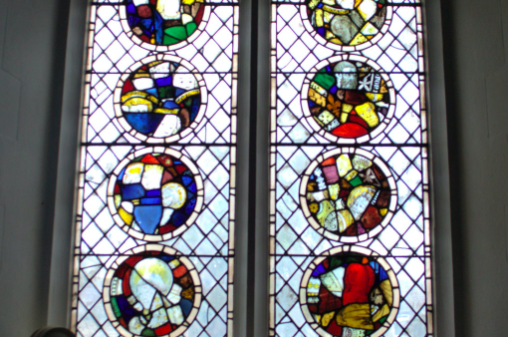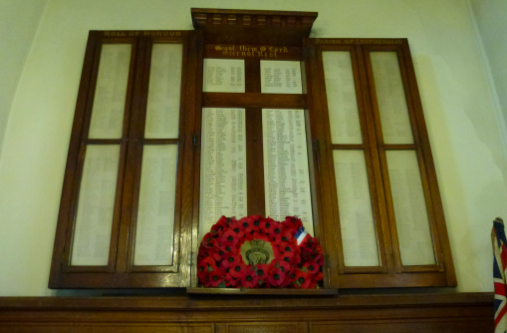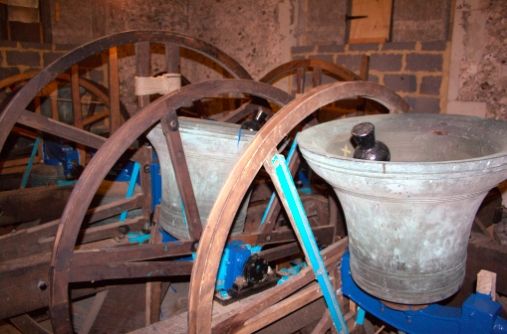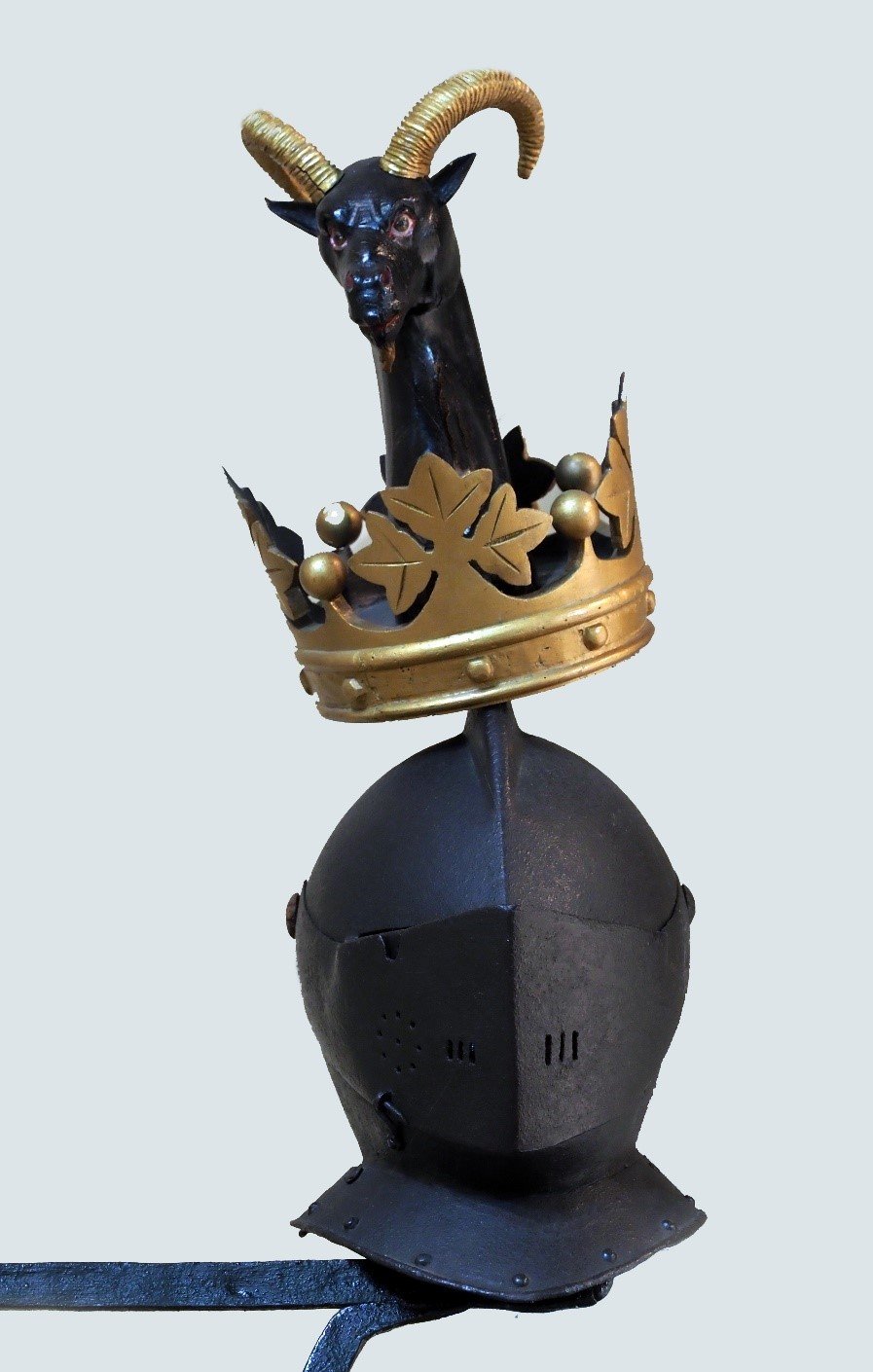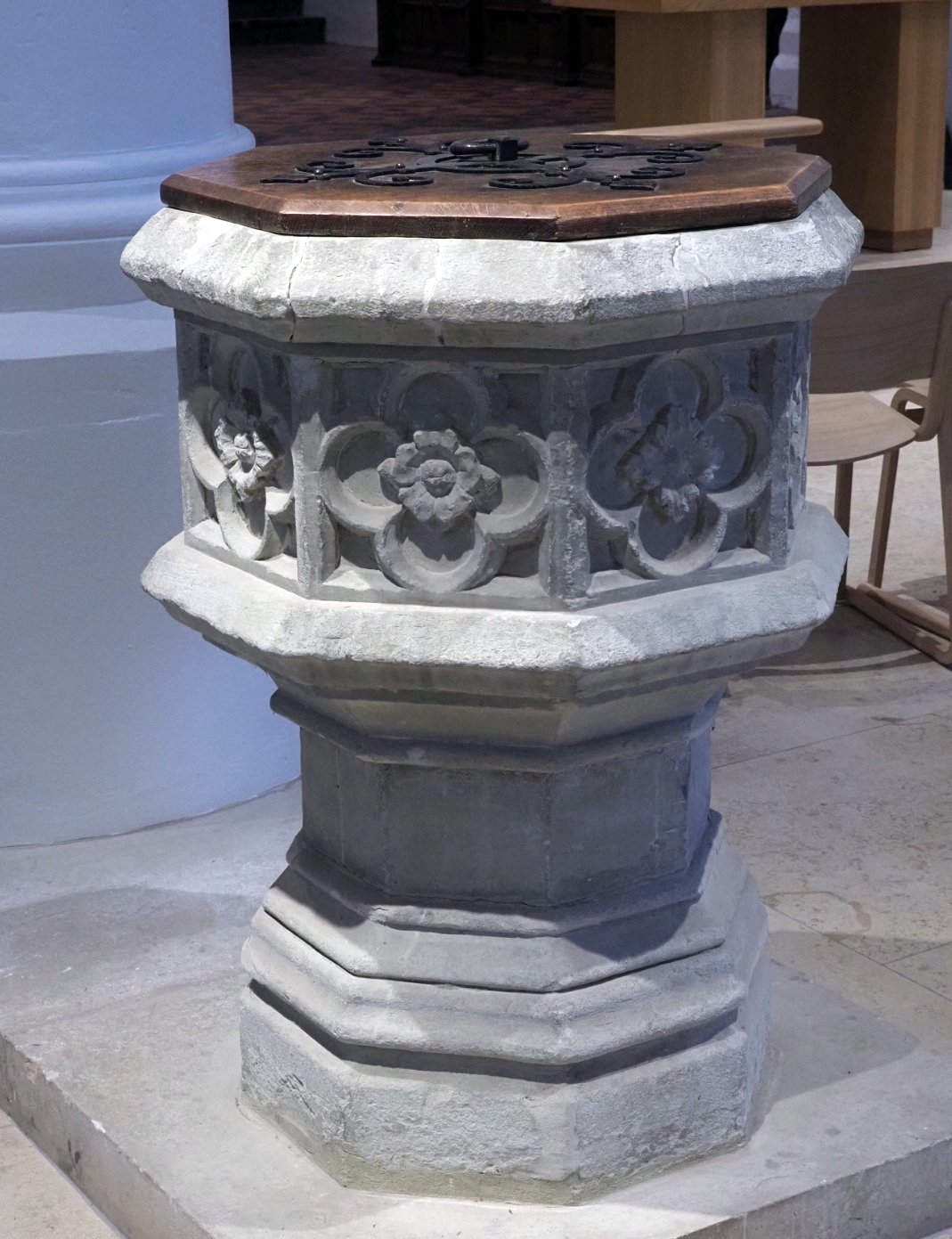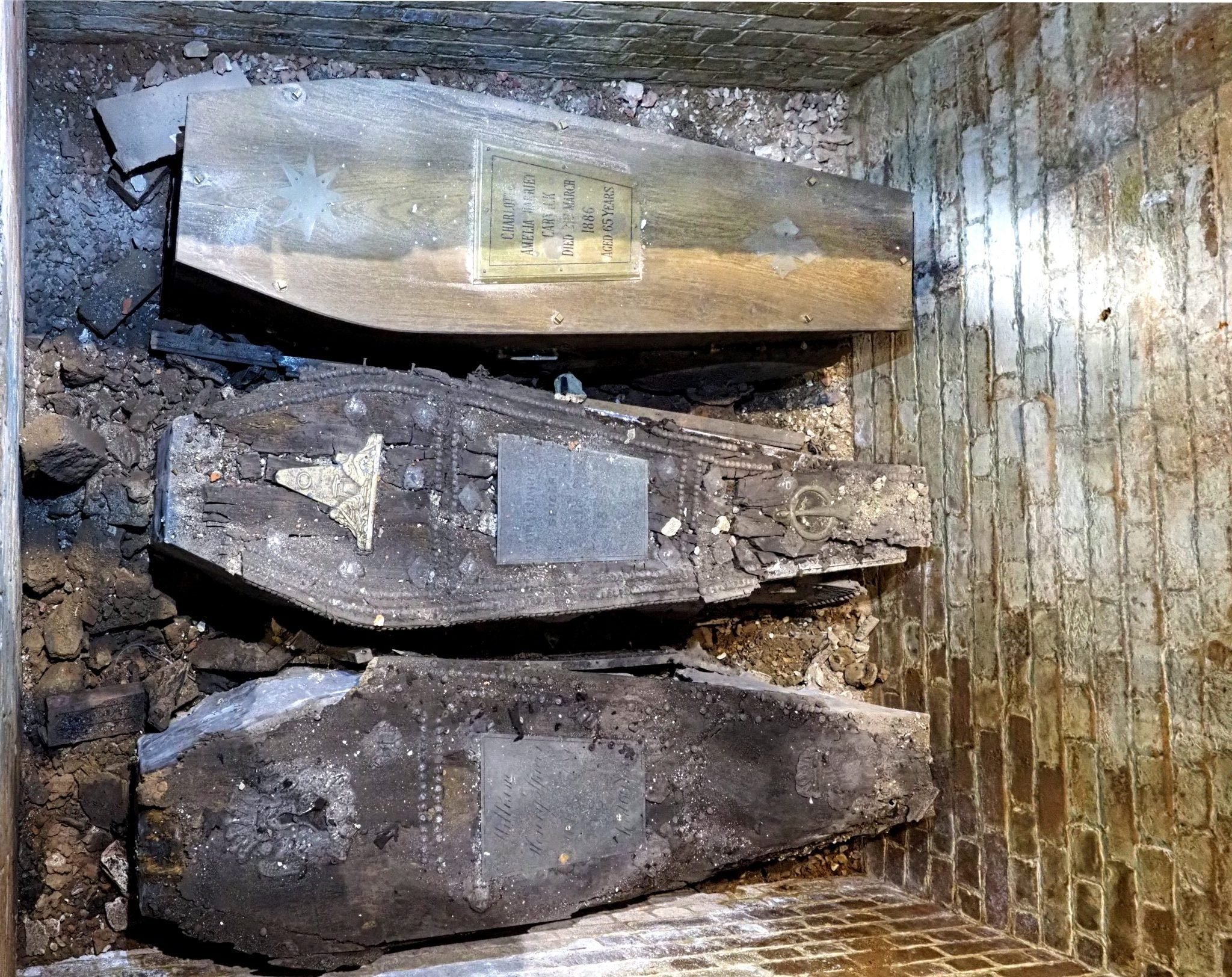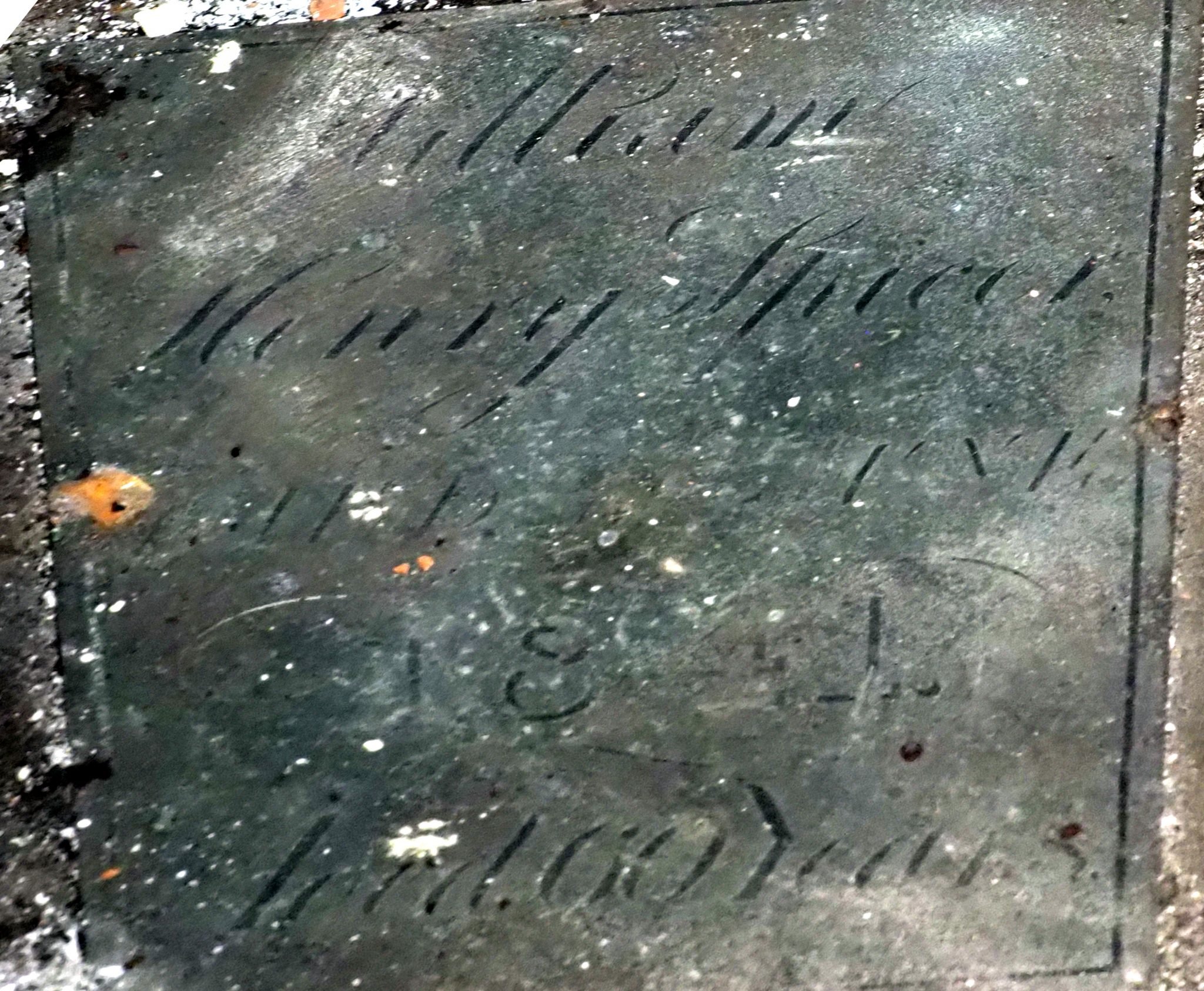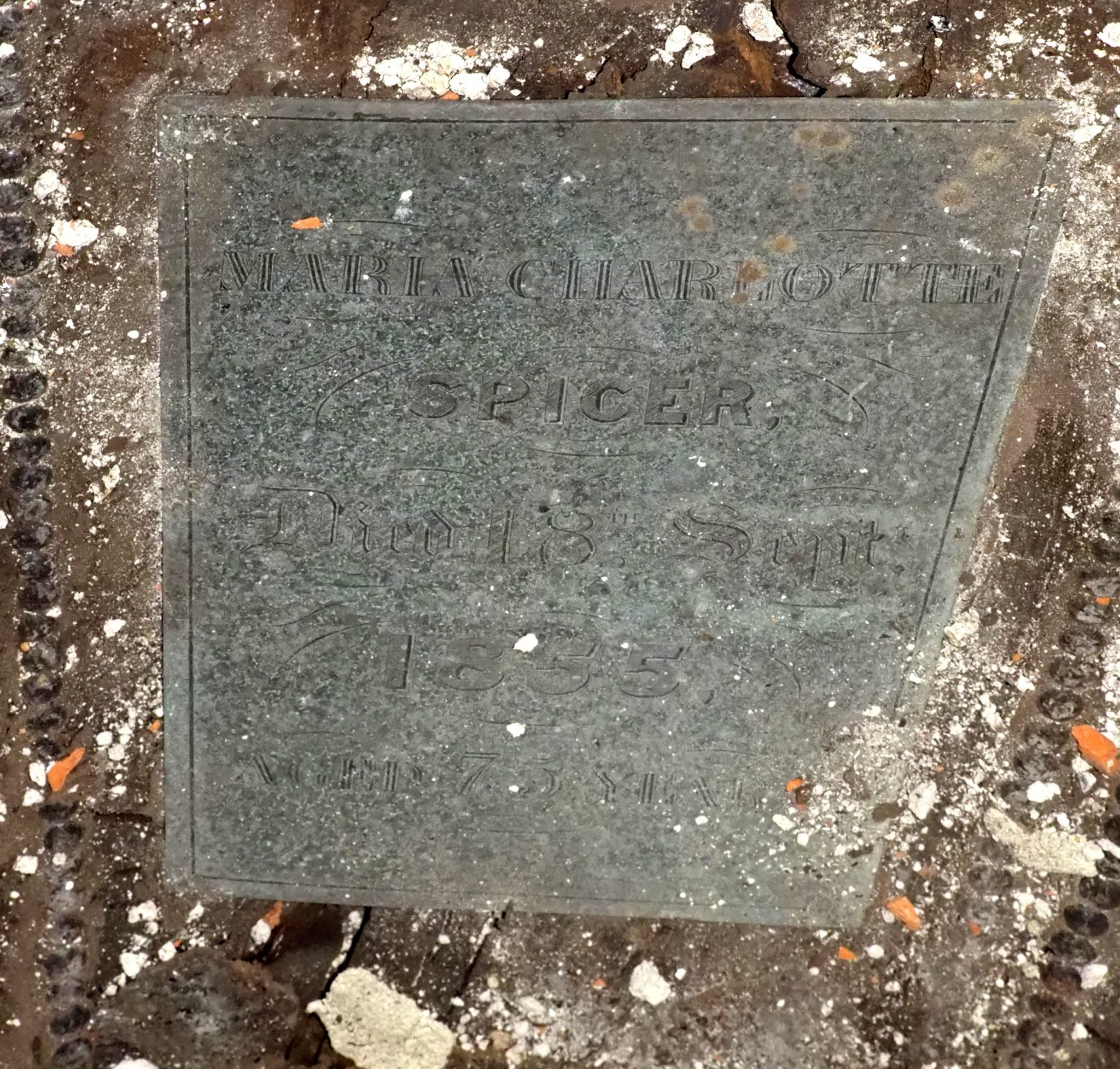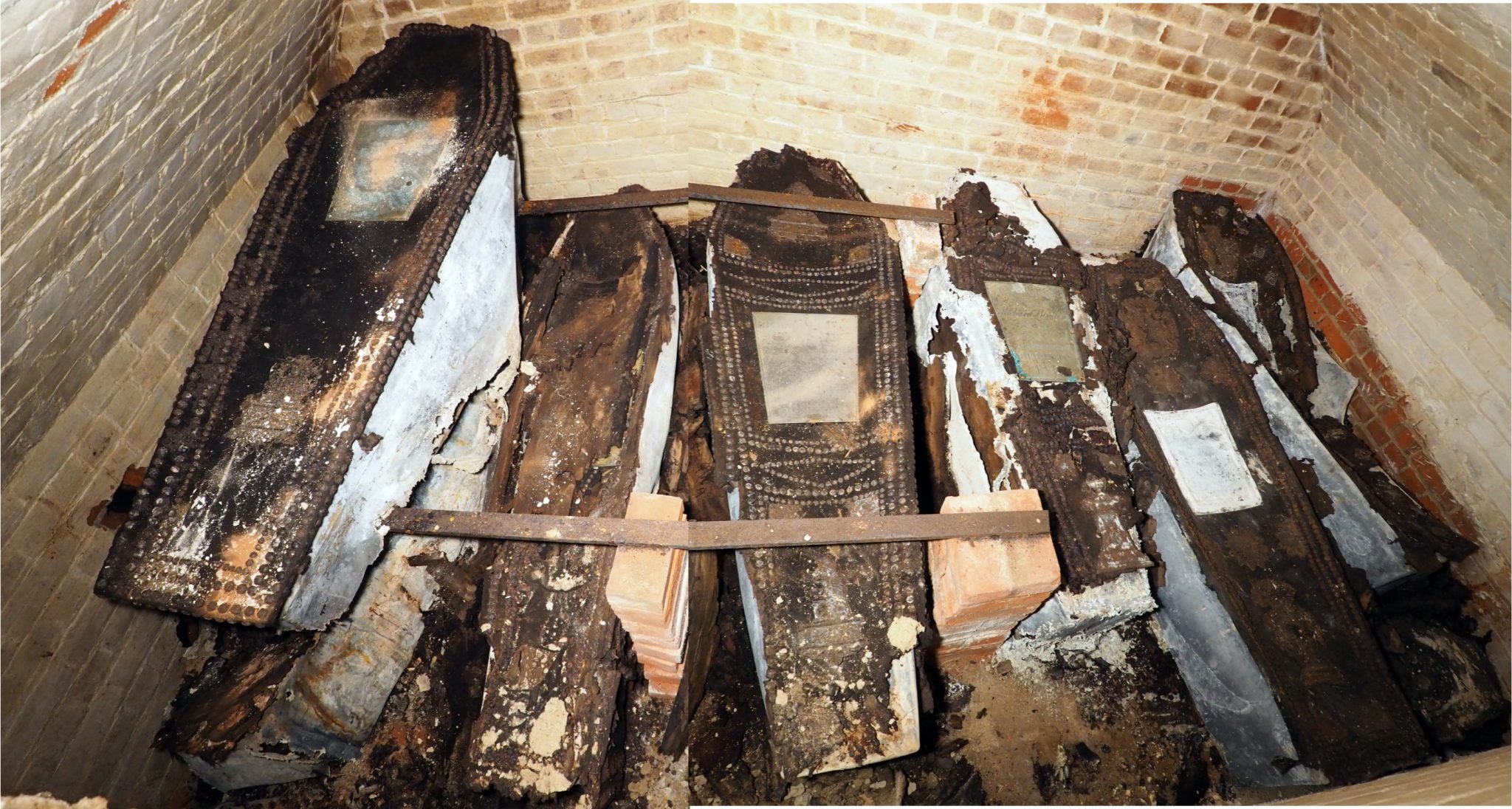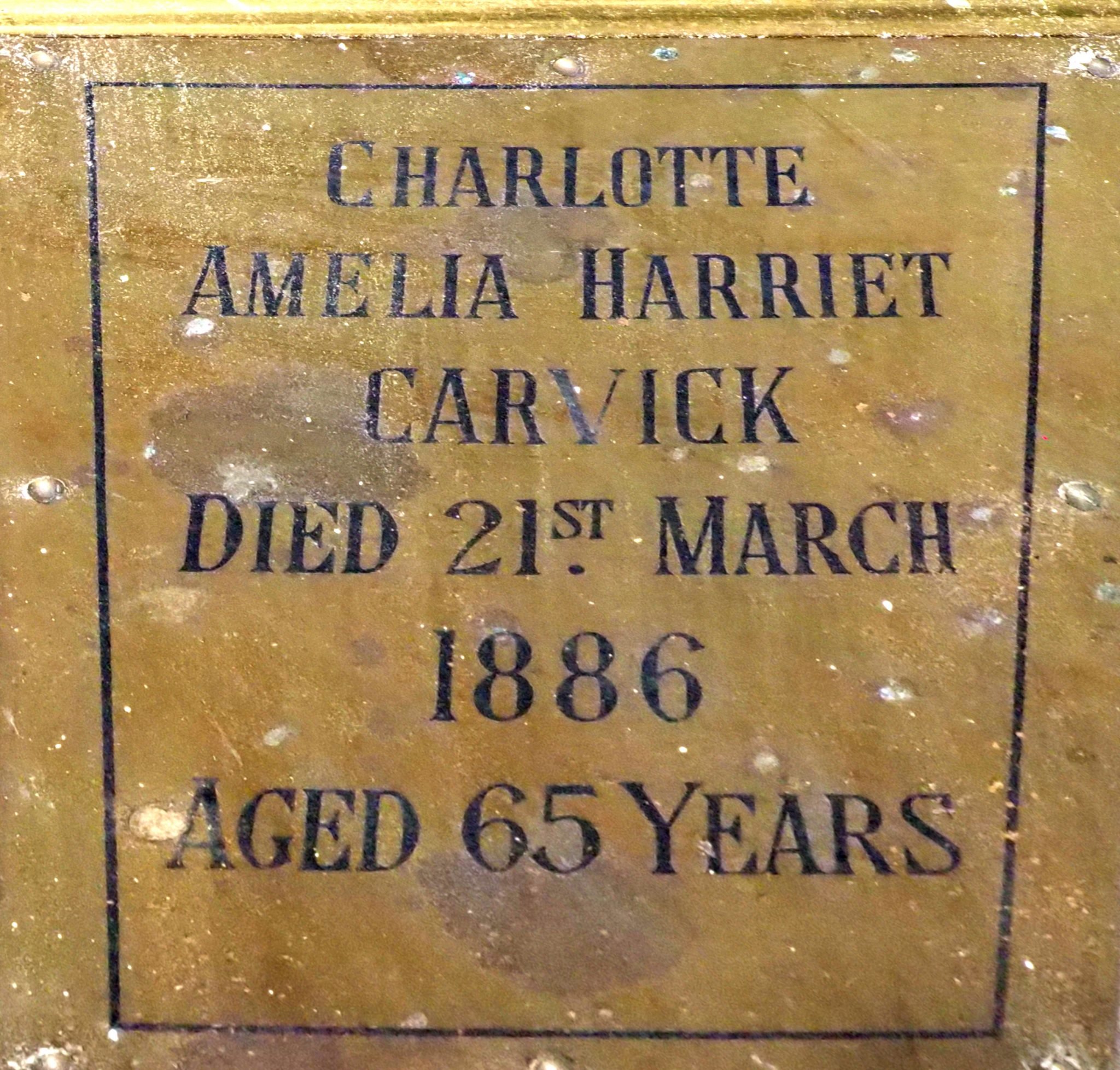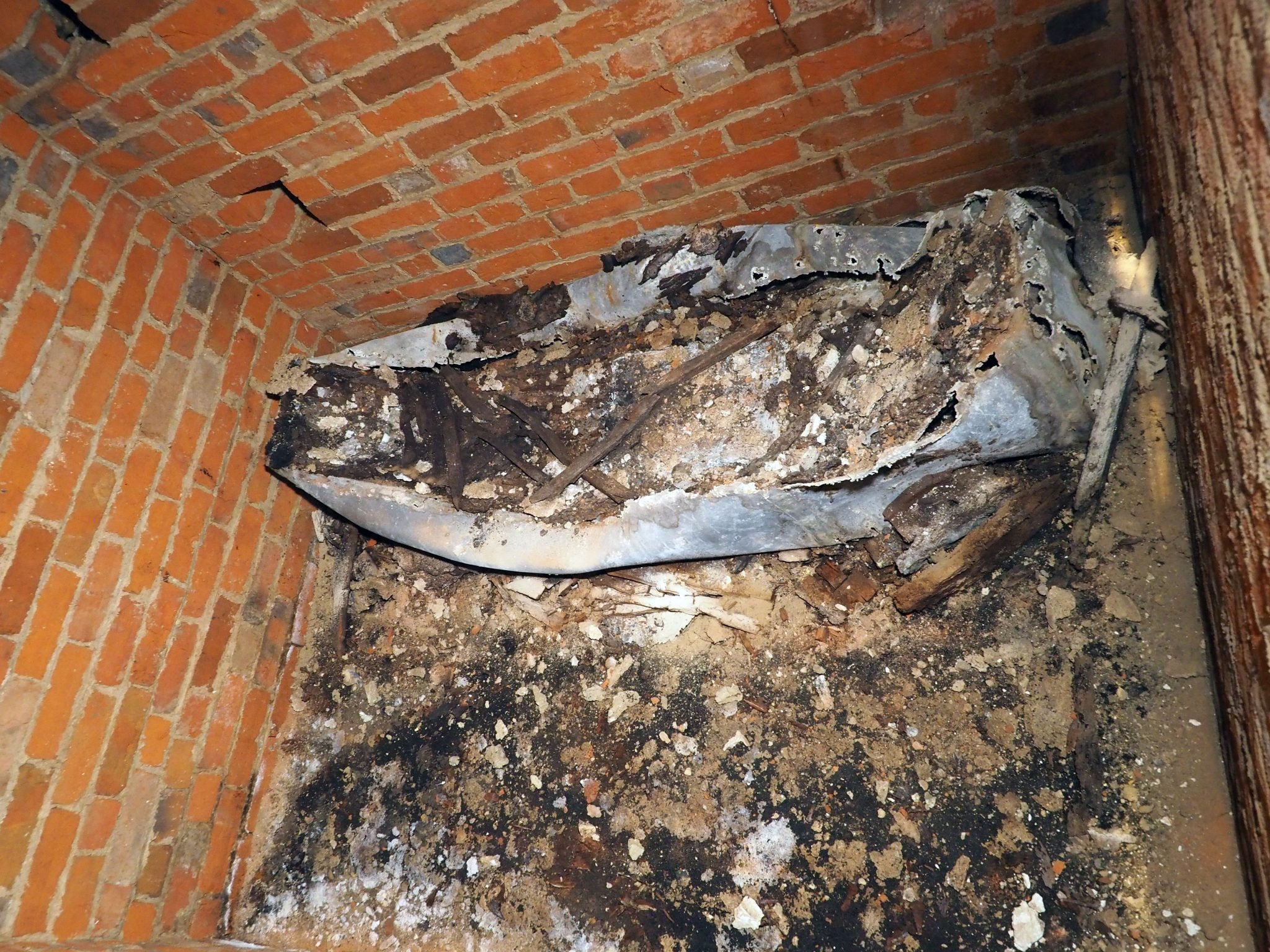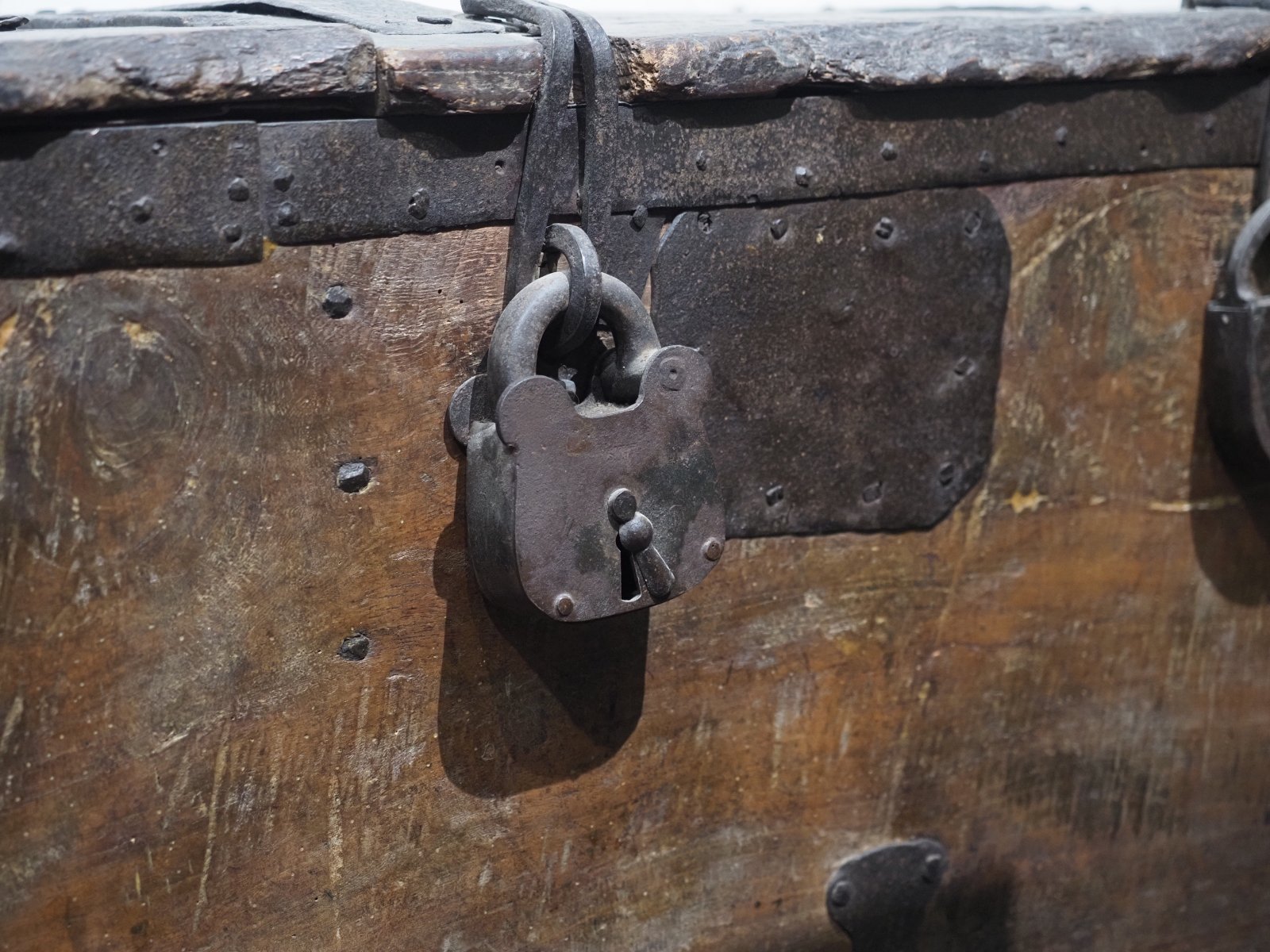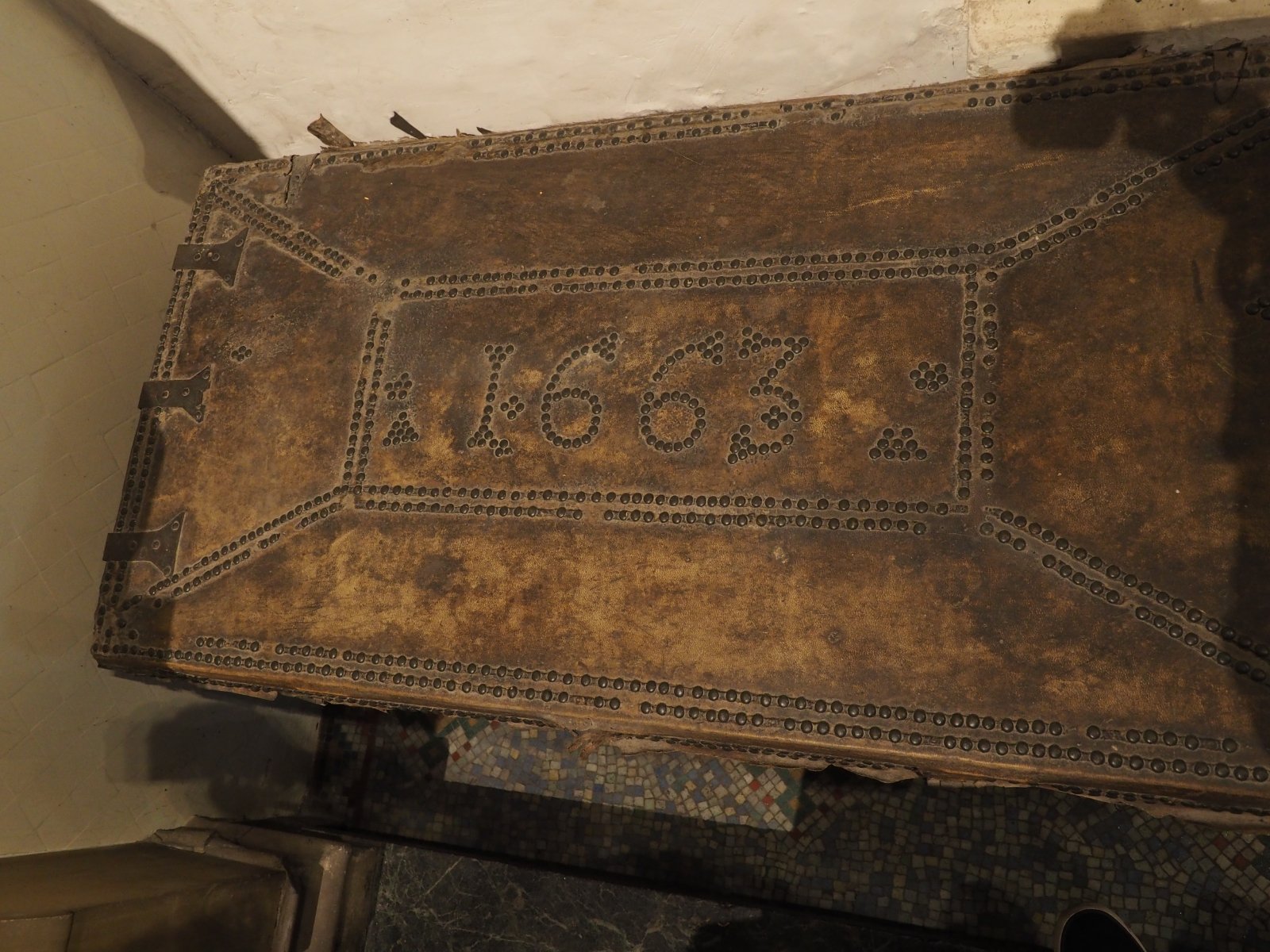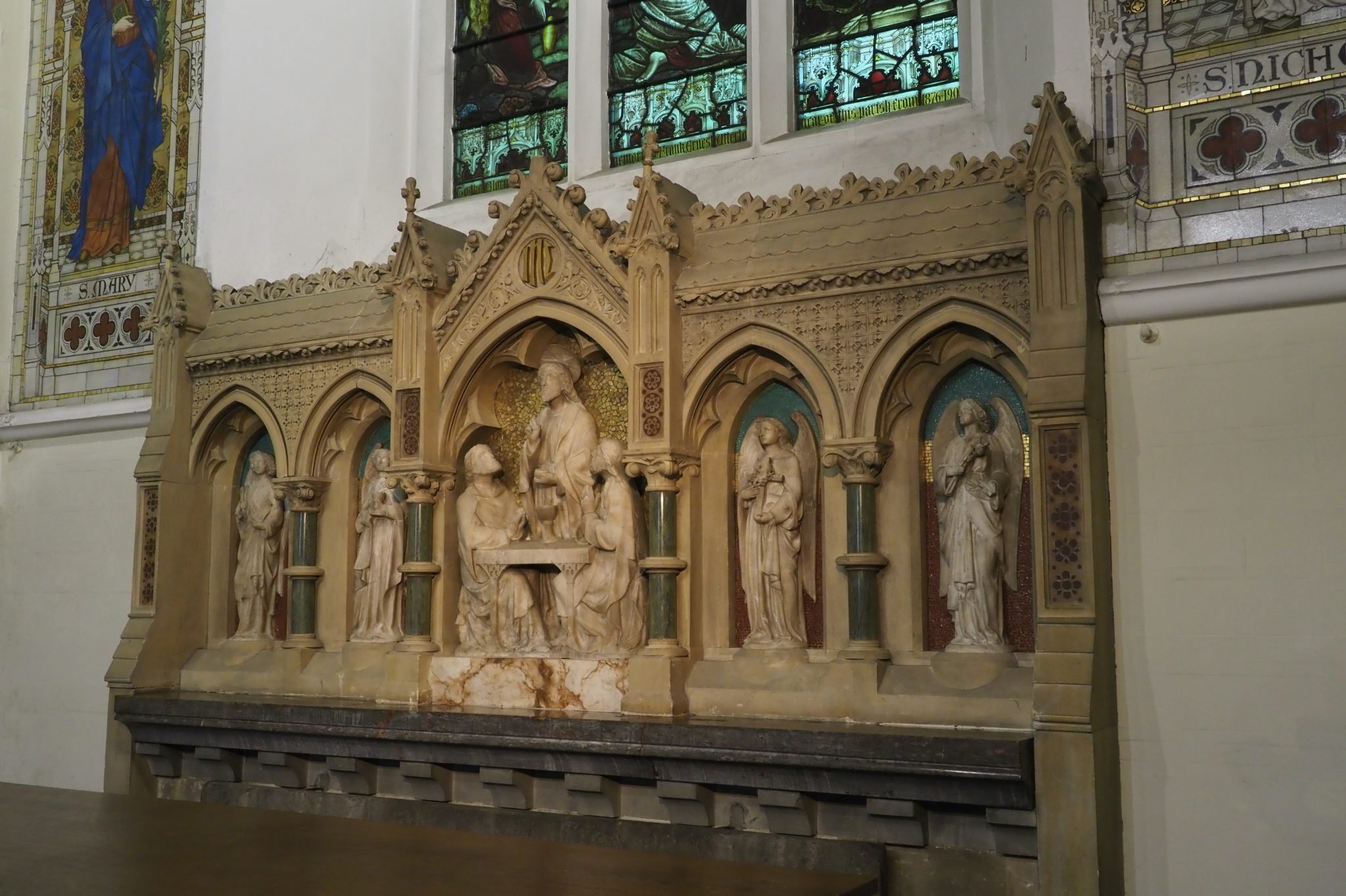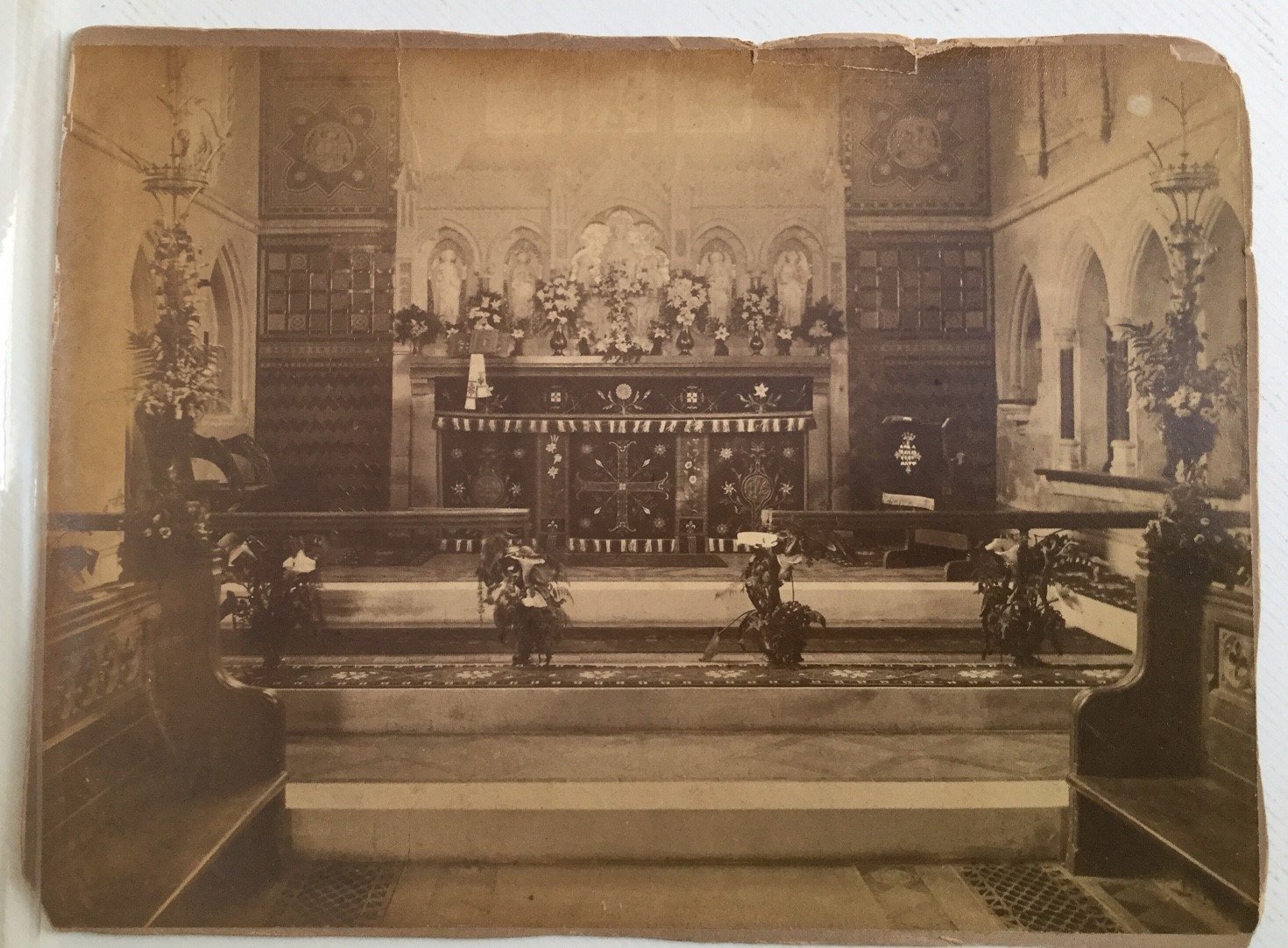
Heritage Highlights
We feature here some of the highlights you can discover on a visit to Leatherhead Parish Church.
-
This unusual window near the North door was installed in its present form in 1948 and commemorates the Rev. G.H.B. Coleridge and his wife.
It contains fragments of medieval stained glass collected by the Rev’d James Dallaway, a noted English antiquary, and vicar of this church between 1804 and 1834.
The other stained glass windows in the church depict biblical scenes more typical of the Victorian era.
The window is divided into sections, known as tracery lights. The two main lights each feature four circles that line up vertically. Each circle contains fragments of medieval glass arranged in a way that creates a random patchwork effect.
The fragments of human figures, birds and animals, inscriptions, fabrics, and other less discernible objects, are depicted in vivid colours of red, blue, gold, green, wine and purple. They all contribute to the beautiful appearance of this window, which is otherwise mostly plain glass with a swirled effect. Standing in front of the window, you may just be able to pick out the delicate peach-coloured glass that frames the circles and the glass surrounds of the window.
The window was not always located here. After the Rev James Dallaway collected the pieces of medieval glass in France, he placed them in a window, which was originally located at the East End of the chancel. In his book, Etchings of Views in the Vicarage of Letherhead, he notes how he “liked the effect of the warmth produced by the light coming through rich colours of the stained glass onto the whitewashed walls of the church.”
However, in 1863 that window was replaced by a memorial window for the Henderson family of Randalls Park. It appears that the Dallaway glass was then moved to the South transept before being replaced by yet another memorial window to Bishop Utterton. So, the glass lay forgotten in crates above the vestry until it was rediscovered in 1939 by the then vicar, the Rev G H B Coleridge (great-grandson of the poet Samuel Taylor Coleridge).
According to the Vicar’s letter in the August Parish Magazine of 1939, he called in an expert from the Victoria and Albert Museum to examine the glass. As well as medieval glass, there were two panels of English glass dating from the 1800s.
In 1946 the panels showing Death on a Pale Horse and Saul visiting the Witch of Endor were donated to the V&A, while the medieval glass was retained by the church and assembled into a window. This was dedicated to the Rev’d Coleridge and his wife. The inscription across the base of both windows therefore reads:
THIS ANCIENT GLASS COLLECTED BY A FORMER VICAR HAS BEEN / REASSEMBLED IN MEMORY OF GERARD HARTLEY BUCHANAN / COLERIDGE : VICAR : OF THIS PARISH : FROM 1926 TO 1944 AND OF / HILDA AUGUSTA HIS WIFE : BY THEIR FAMILY AND FRIENDS
-
An imposing 15th century church tower with beautiful views of Leatherhead, the Mole Valley, and painted by landscape artist, Turner (1775-1851)
-
The tower was completed in 1480.
Originally, it had a wooden spire on top, but this was blown down in the great storm of 1703. In 1795 the doors were widened to house the town’s fire engine.
Over the years the number of bells housed in the tower has varied.
From first records in 1549 of four bells, to one in the Reformation, through various re-castings and augmentations to reach the ring of ten we have today
-
TIMELINE FOR THE BELLS
1549 – Four Bells
Valuation of church furniture in 1549 there were four bells in the tower One of the earliest references to the bells is in 1770 when the entire frame was replaced.
1792 – Six Bells
Above the door of the belfry is the peal board confirming that the last peal rung on the six bells was on the 30th July 1792.
The six old bells were recast hung on the old six-bell frame and another frame was added to accommodate the two new trebles. The new ring of eight bells were first rung less than a month later on the 21st August 1792.
1816 – Eight Bells
In 1816, several bells were recast and a heavier ring resulted but three of the 1792 bells were rehung. A new treble was added others moved and four new bells were cast to complete the ring of eight.
1877 – Ten Bells
In 1877, the old bells dated 1792, were cracked and it was necessary to recast them.
AJ Miller of Emlyn House (now called ‘Mansion House’) gave two new trebles as a memorial to his first wife to complete the ring of ten.
1900s
November 1923. The bells were dismantled and lowered to the ground. A photograph in the belfry shows them on the path outside the west door waiting transportation to the foundry.
An entirely new frame and fittings were installed and all the bells were tuned and rehung on ball bearings. The ninth bell was cracked and was recast. The first peal on the newly hung bells was rung on Easter Sunday, 1924.
The Leatherhead bells were re-tuned in 1964 resulting in the present ring of ten.
On the 20th January 2008, they were completely dismantled, the bearings were replaced and the frame refurbished.
-
The most prominent graffiti, by the Tudor door to the Tower reflects the use of the gallery as a schoolroom during the 17th and 18th centuries.
The earliest graffiti (HB 1625) was cut when King Charles I ascended to the throne.
JOHN FOXE 1666 carved his name into the stonework in the year of the Great Fire of London, when the occupant of Thorncroft Manor, Sir Thomas Bludworth, was Lord Mayor.
16 HE 85 (topped by a crown motif)
JASPER ROGERS and JR (multiple examples can be seen)
HK
RICHARD ROGERS
EoR
R· · ERT NEALE
HVM STACY 1662
HMB
JOHN FOXE 1666
The name Rogers appears frequently in the Registers of Baptisms through the 17th and 18th century but there is only one entry for the name Jasper: July 7th 1713 Thomas, James and Jasper sons of John Rogers. A Richard Rogers was baptised on March 11th 1673.
Numerous graffiti are visible in the western half of the church. However, the majority are no longer decipherable being shallow, incomplete, worked over or filled with paint. The area around the doorway to the Tower staircase and the north side of the Tower arch is where most of the deeply cut names and initials can be seen.
18TH TO 20TH CENTURY GRAFFITTI
Initials and names of the 18th to 20th centuries, with a varying degree of legibility, occur around door and window openings and on the curving soffit of the stairs. They are most in evidence on the doorway to the Ringing Chamber
SCRATCH DIALS
On your way back out through the North Porch, you may be able to spot three possible scratch dials with other marks one above another on the inside edge of the entrance. All are in poor condition and only the topmost circle has been confirmed as a scratch dial by the British Sundial Society.
As scratch dials are normally found on external south facing surfaces we are not sure if these stones have been reused. A possible source could be the blocked doorway to the South Aisle.
-
The names of the Leatherhead men who gave their lives in the Great War are listed on the centre panel of the oak War-Shrine.
The names of all who served in WWI are listed on the side panels. The RBL Roll of Honour commemorates the fallen of both WWI and WWII.
The triptyck (three panelled outdoor war shrine) was donated by the ladies of the town and placed in the Parish church after the dedication of a permanent War Memorial in 1921.
THE HISTORY OF THE TRIPTYCK
121 names are listed alphabetically by surname in two columns on the centre panel of the triptyck. The month and year of their death is also shown. Those who served are on the Side Panels. The starred names denote those killed in action.
Leatherhead’s high casualty rate during WW1 led to an early call for the fallen to be commemorated by a roll of honour.
The Triptyck was carved by C. E. Grantham from a design submitted by the women of Leatherhead who funded it. The inscriptions at the top and bottom of the centre panel read:
Grant them O Lord/ Eternal Rest
Greater love hath no man/ than this, that a man lay/ down his life for his friends.
It was originally dedicated by the Bishop of Winchester on 21 March 1917, when it was first unveiled on the south side of the Clock Tower that stood in North Street. Following the creation of a permanent stone memorial in the same street, the triptych was relocated to the Church. The Vicar of Leatherhead rededicated it on 4 December 1921
-
Simple wooden crosses marked the graves of soldiers where they fell on The Western Front in WW1. As permanent grave stones were erected, the markers were offered to relatives.
-
The wooden grave marker from the battlefields of the Great War is for 510102 Private Francis Charles Brockett Coward, A Coy. 1st/14th Bn., London Regt. (London Scottish), who died on 29th August 1918, age 26.
Private Coward is buried in the Honourable Artillery Company (HAC) Cemetery at Ecoust St Mein, in the Pas de Calais, grave reference V.K.21.
He was awarded the British War Medal and Victory Medal and (posthumously) the 1914 Star Medal.
-
CONNECTION WITH LEATHERHEAD
Private Coward is not named on any of Leatherhead’s war memorials. Furthermore we don’t know how the WW1 battle cross ended up in this Parish Church. However, it was common for the wooden markers to be offered to the next of kin when replaced by a permanent headstone.
Private Coward’s war grave located in the Pas de Calais has been commemorated with a Portland stone headstone. When the Imperial War Graves Commission recorded the headstone in the 1920s, Francis’ mother was living in London.
However the Burial Register for Leatherhead Parish Church, entry no.1680, shows that Francis’ father, Samson Coward, was buried in the churchyard on 2nd April 1896. There is no gravestone in the churchyard today. Since Samson died at the young age of 35 years, perhaps there never was!
Samson was recorded as a Keeper when his daughter Vera was baptised in1894. When another daugther was baptised a year later, he was an Ostler (someone who looks after horses at an inn). In both entries he was living at Church Street, Leatherhead.
-
The striking funeral helm of Robert Gardiner includes elements from his heraldic crest.
The funeral helm of Robert Gardiner of Thorncroft (d.1571), and Sergeant of the Wine Cellar to Queen Elizabeth I.
A transcription of Gardiner’s epitaph by Thomas Churchyard, the Queen’s poet, can be seen on the wall below the helmet.
-
ROBERT GARDINER OF THORNCROFT
Little is known about the ancestry of Robert Gardiner except that he originally came from Lancashire. We know he was present at the Coronation Banquet of Anne Boleyn at Westminster Hall in 1533. He married Anne, the daughter of Robert Dethick of Greenwich, who was armorer to Henry VIII.
Robert rose through the ranks by seniority from groom to yeoman, and from yeoman to sergeant. The first time we hear of him being referred to as Sergeant of the Wine Cellar is when his crest of a goat’s head out of a coronet was confirmed on 3rd April 1560.
Gardiner leased Thorncroft Manor in Leatherhead sometime around 1545. He went on to purchase further freehold land in the area. Thorncroft stayed in the family for 100 years.
Although during the excavations of 2019, we found no evidence of his burial casket, his desire to be buried at Leatherhead is documented in his will dated 4th February, 1570/1 – “my parish church, in the church before my pew, if it please God to call me to his mercy when I am within thirty miles thereof.”
-
PLATES BELOW THE HELMET
Three plates are fixed to the east respond beneath the helmet.
The first displays a blazon (coat of arms) with mantling (a piece of ornamental drapery shown flowing from a helmet and surrounding a shield) and helmet engraved into the metal.
The second rectangular plaque has a verse engraved in gothic black letter, which describes the attributes of Robert Gardner’s life. The words were written by the poet to Queen Elizabeth 1.
The third is a small rectangular plaque with a dedication in gothic black letter. Amazingly Sir Robert Gardiner lived to be 83 years old. Infant mortality was high in 16th century. However, if you reached your 12th birthday you could live to be very old.
-
“Here ffryndly Robertt Gardnar lyes,
well borne of ryghtt good race,
Who sarved in corwtt wyth credytt styll,
in worthi rowlm and place;
Cheef Sargantt of the Seller longe,
where he dyd duetty shoe,
Wyth good regard to all degrees,
as ffar as power myghtt goe.
He past hys youth in sutch good ffraem,
he cam to aeged years;
And thearby porchaest honest name,
as by report apeers,
A ffrynd whaer any cawse he ffound,
and corttes un to all.
Off myrry moode and plessantt spetch,
howe ever happ dyd fall
Ffowr chyldern for to ffornysh fforth,
the table rownd ha had.
Wyth sober wyeff, moest matron lyk,
to mak a man ffull glad.
Prepared to dye longe ear his day,
which argues gratt good mynd:
And told us in the other world
whatt hoep he had to ffynd.
We leave hyme whear he loektt to be
our Lord receive hys spreet
Wyth peace and rest in Habram’s brest,
whear we att leynth may meet.”
~
He departed owte of this transitory worlde
the 7 daye of November Anno dm. 1571
being of the age of Lxxxiii yeres.
-
Here friendly Robert Gardiner lies,
well born of right good race,
Who served in court with credit still,
in worthy realm and place.
Chief Serjeant of the Cellar long,
where he did duty show,
With regard to all degrees,
as far as power might go,
He passed his youth in such good frame,
he came to aged years;
And thereby purchased honest name,
as by report appears.
A friend, where any cause he found,
and courteous to all;
Of merry mood and pleasant speech,
however hap did fall.
Four children for to furnish forth
the table round he had
With sober wife, most matron like,
to make a man full glad,
Prepared to die long ere his day,
which argues great good mind.
And told us om the other world
what hope he had to find
We leave him where he looked to be;
our Lord receive his spirit,
With peace and rest in Abram’s breast,
where we at length may meet.’
~
He departed this transitory world
on the tenth day of November A.D. 1571,
being then of the age of 83 years
-
Every medieval church contained a font. Our font continues to play an important part in baptism services
The 15th century octagonal font is made of Reigate stone, each panel carved with a quatrefoil enclosing a diamond shaped foliage ornament.
-
Every medieval church contained a font. It was close to the main entrance of the church in an area known as the baptistry. However fonts were often moved elsewhere in the church, as is the case with this one.
The Parish Records of 1871-1892, held at the Surrey History Centre, indicate that the font was moved from near the Chancel steps to the North Aisle in 1891.
In 1997 it was again moved to under the Tower arch, before being moved as part of the Making History project completed in 2020. From its current location in the nave between the first and second pillars of the North Aisle, there are improved sight lines to the font for Baptismal services.
-
18th & 19th century brick domed family vaults lie concealed beneath the north & south transepts. Excavations during 2018/19 revealed new insights into their history.
-
NORTH TRANSEPT
Before excavations in 2019, the brick domed vaults in the North Transept were thought to belong to two influential Leatherhead families (Gore & Spicer).
They lived at the Mansion House (now the Leatherhead Registry Office) in the 18th and 19th centuries respectively.
-
18th & 19th century brick domed family vaults lie concealed beneath the north & south transepts. Excavations during 2018/19 revealed new insights into their history.
-
According to the wall monument in the church, William Henry Spicer was born on 23rd March 1778 at Wear Park in Devonshire, although some historians state 1777. He joined the 27th Light Dragoons as a Cornet in 1795, transferring to the 5th Dragoon Guards with the rank of Lieutenant in 1796. He served in Ireland and the island of Walcheren in 1809, after which he retired. He married Maria Charlotte Prescott at St Marylebone Church in London on 29th January 1810. They had four children, but only Charlotte is interred in the family vault here.
-
Maria’s memorial shows she was born on 11th June 1780, the daughter of Sir George B. Prescott, Bart of Theobalds Park, Herts. She married William at St Marylebone Church in London on 29th January 1810. Together they had four children.
-
Charlotte married Thomas Mayer Carvick, previously an officer in the 78th Highlanders in 1843.
-
WADE VAULT (FORMALLY GORE)
We were, however, surprised by the findings within the second vault, which had been badly fire damaged following an electrical fire in 1987. We expected the single fragile casket to belong to Henry Gore (d. 1777) or perhaps his father Lieutenant-Colonel Humphrey Gore (d. 1739). Both men have memorials within the church. But on closer inspection the casket was in fact inscribed with a name plate to William Wade (d. 1809). He was the husband of Catherine Wade (Henry Gore’s daughter, d. 1787).
Catherine’s exposed and damaged casket, was also unexpectedly found nearby in the floor, along with the ledger stone of her mother, Hannah Gore (d. 1752), which you can still see inlaid in the floor today.
-
South TRANSEPT
The large vault concealed below the floor in the South Transept completely fills this space. It contains seven caskets, all members of the Boulton family.
The Boulton family owned Thorncroft Manor in Leatherhead between 1763 and 1859. From 1781 they also held the title of Lordship of the Manor
-
The first Henry (Crabb) Bolton d. 1773 was Chairman of the East India Company and in 1754 became MP for Worcester. He remained an MP until his death on 8 October 1773. Being unmarried, he left his estate to his brother Captain Richard Crabb, who took the Boulton name.
His son Henry inherited four years later and it is he who is buried here. According to a newly obtained family tree Henry and his wife Julianna Boulton, had 10 children rather than the 7 previously documented. Frances, Richard, Sophia, Juliana, Maria, Harriet, Emma, Henry, Charles and Louisa were all born at Thorncroft Manor in Leatherhead and christened here.
-
“The King has been pleased to grant unto Richard Crabb of London Esq and Henry Crabb his only son and their issue the Royal Licence and authority to assume the name of Boulton in compliance with the will of Richard Boulton late of the Parish of St Olave Hart Street in the City of London Esq deceased and also to order that His Majesty’s concession and declaration be registered in the College of Arms”
(London Gazette 30th October 1773)
-
JULIANA BOULTON D. 1813 (PRESUMED)
Juliana, was the second daughter and co-heir of Sir Charles Raymond of Valentine House, Barking, co. Essex, Baronet. She married Henry Boulton at St Helen’s, Bishopsgate, London on 3rd November 1774. They were married 40 years until she died on 12 December 1813, aged 60. Although the inscription on the casket could not be read, a memorial to her is on the west wall of the South Transept, which includes the words ‘Beneath are deposited the remains of JULIANA BOULTON’ suggests that she was the first Boulton to be buried in the vault.
A photo of a miniature of “Mrs Boulton” bearing the following inscription: ‘Juliana Boulton daughter of Sir Charles Raymond Bart Died 12 December 1813, Aged 60’ was kindly shared with us by a direct descendant of Charles Boulton. The frame holds locks of Juliana’s hair, displayed behind glass on the reverse.
A handwritten note in the case reads ‘London. March 1914. Painted by Henry Bone RA. Enamel painter in Ordinary to His Majesty & enamel painter to HRH the Prince Regent, after a miniature by George Engleheart’, which is in the collection of the Victoria and Albert Museum.
-
Son of Richard and Frances Boulton, and nephew of Right Honourable Henry (Crabb) Boulton. ‘Our’ Henry Boulton was born on 20 August 1752 and christened at St Helen’s Bishopsgate on 26 August of the same year. He joined the board of the Sun Fire Insurance Company in 1780 and was one of the founders of the Sun Life Association, where he was trustee and auditor from 15 August 1810 to 7 April 1826. He resigned due to indisposition on 7 July 1826. He was also Governor of the Corporation for Working of Mines, Minerals and Metals in Scotland between 1819 and 1825.
In 1783 Henry was High Sheriff of Surrey. Around that time he commissioned George Gwilt, the surveyor, to produce a large scale map of Leatherhead. A charity board in the ringing chamber of the Tower records that he gave land in 1807 for the House of Industry to be built and offer relief to the destitute.
Hunters of Henry Boulton, with dogs were painted by John Nost Sartorius in 1788. The other painting by Sartorius is of Henry with the Surrey Hounds, and is dated 1792. These pictures were sold at Sotheby’s on 8th March 1989.
-
Caroline Shubrick married Richard Boulton at St George’s Bloomsbury on 1 March 1804, although on the marriage licence her name was written as Carolina. She was born in Enfield Middlesex in 1773 and died on 22 January 1849. She is buried in this vault.
A portrait of Caroline, wife of Richard Boulton of Givons Grove, Leatherhead, painted by Hoppner, was sold at Christie’s for 2,400 guineas (year unknown). In the painting she was dressed in white muslin, with blue sash, and her auburn hair is bound with a blue ribbon.
-
The son of Henry and Juliana, Richard was christened on 25 June 1777 at Leatherhead. He is mentioned in his father’s will dated 1822. He died on 19 January 1859 in his 82nd year.
A Richard Boulton was commissioned in the Coldstream Guards in 1794, and retired with the rank of Captain in 1802. Although there is no firm evidence that this was him, the dates appear to fit.
The holdup of a mail wagon by two men just opposite Givons Grove, as it travelled from Dorking to Kingston. The sound of gunfire brought Captain Boulton and his gamekeeper to the rescue. The mail got through, but the assailants escaped.
The Times, July 1827
-
A memorial on the wall to Charles (son of Henry and Juliana Boulton), and the fact that his younger sister subsequently requested to be buried beside her brother, would suggest that the 5th casket belongs to him. Charles succeeded his father as Governor of Sun Fire in 1825.
This watercolour of Charles was painted by his sister Sophia.
-
Mentioned in The Diary of Samuel Pepys, Richard Dalton became a tenant and was reported to have drunk with him in the old wine cellar two or three times.
A row of ledger stones of polished slate and a large ornate baroque monument of black and white marble and bronze dedicated to members of the Dalton family.
Richard Dalton (d.1681), was Sergeant of the Wine Cellar to King Charles II and the younger Richard (d. 1731) was successively Page, Groom and Yeomen of the Cellar under Charles II and William III.
-
OBELISK AND SARCOPHAGUS
The large baroque monument is made of black and white marble, and bronze. It dates to the second quarter of the 18th century.
The obelisk shaped inscription panel displays the Dalton blazon with its motto MIHI SEMPER DEUS (God for me) and commemorates father and son:
NEAR
THIS PLACE
IS DEPOSITED
RICHARD DALTON
ESQ;
SERGEANT
OF THE WINE CELLAR
TO KING CHARLES II
HE DYED
OCT. IV. M.DC. LXXXI.
AGED LXV
AND OF
RICHARD DALTON
ESQ
HIS SON
WHO DYED
NOV. XXIV. M. DCC. XXXI.
AGED
LXXXIV. YEARS X MONTHS
-
The Parish chest was the safe of its day. Secured with three metal padlocks, each opened by a different key, held by different people, ensured the safekeeping of the contents.
The long wooden chest with metal rim and three large padlocks is thought to date from the 13th century, while the second large leather studded chest dated 1663 came from Slyfield Manor.
The three locks on the Parish chest prevented any single individual from accessing the contents that probably included vestments and valuable artefacts.
-
The ancient wooden chest is 182cm in length and has four locks – three large padlocks and one open lock. There are five metal hinges along the lid and five metal straps along the bottom.
The lid is divided into two sections. The chest has a metal carrying ring at the right end and is balanced on two wooden feet. Raising the chest above the floor would have protected documents and garments from the damp.
-
This Parish chest would have originally stored church documents. Made of wood and leather, double rows of studs create a pattern on the top and front of the chest. A central rectangle on the lid contains the date of 1663.
There are metal straps on the front corners, the ends and corners of the lid and four locks that do not connect. The chest is said to have come from Slyfield Manor.
-
The highly decorative reredos behind the altar is an elaborate work of the Gothic Revival, particularly popular in the Victorian era.
Made of marble, Caen stone, alabaster and mosaic, the reredos was erected in memory of the Rev Benjamin Chapman in 1872.
It depicts the Last Supper with angels bearing symbols of the Passion either side.
Commissioned in 1911, the opus sectile mosaic panels of St Mary and St Nicholas on the wall are a memorial to Frank Utterton, the late Archdeacon of Surrey and vicar here for 30 years.
-
Estimates for the new reredos, signed W Earp, were addressed to the incumbent on 28 August 1872 on notepaper bearing Arthur Blomfield’s address. This suggest that as architect for the forthcoming restoration of 1873, he may have had an involvement in the design of the reredos.
The estimates were for £130, or £120 without mosaics, or £120 with stone figures in lieu of alabaster.
You can see that the central recess is backed with gilt mosaic and contains three alabaster figures representing the Last Supper. The four recesses also contain alabaster figures of angels bearing symbols of the Passion and have red, green and gold mosaic backgrounds. So, we know which design was eventually selected.
In the picture of the High Chancel dating from 1883, you can see the marble reredos installed before the later addition of the panels that feature St Mary and St Nicholas were erected.
An original altar stone stands against the wall behind the altar. It is somewhat surprising that this survived destruction during The Reformation.
-
When the chancel was extended in 1320 the south wall incorporated a piscina for washing the altar vessels, and a sedilia with three seats for the clergy.
-
The piscina is in the circa 1320 extension of the Chancel and its design accords with that date but original work is not evident.
The three recessed seats made of stone with polished shafts were for priests to seat in.
The niche (Piscina) beside it was for the disposal of holy water used to wash communion vessels.
-
The three seat sedilia and piscina were part of the original 14th century extension (circa 1320) of the Chancel. Its design matches with that date, but the original work is not evident.
A letter from the Ecclesiastical Commissioners’ architect in 1873 includes the sedilia and the piscina in items which were restored. The poor condition of the plaster today is due to later generations using paint that did not allow the walls to breathe.
A drawing from 1820-30 shows a small window in the upper part of the eastern, Priest’s seat, but at some point in time it has been filled in without trace.
-
This space is available for prayer and quiet contemplation, but hidden beneath the floor of the South Transept is the Boulton family vault.
-
The stained glass windows in this Chapel commemorate John Utterton, who was the first Bishop of Guildford (then a suffragan bishop in the Diocese of Winchester) and buried in our churchyard.
The windows were dedicated in loving memory by his family, and affectionate remembrance by parishioners of Leatherhead and other friends.
We invite you to spend time here quietly reflecting on people, who have impacted positively on your life.

